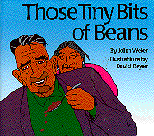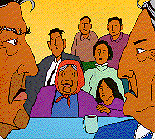

![]()

|
Those Tiny Bits of Beans.
John Weier. Illustrated by David Beyer.
Grades 3 - 5 / Ages 8 - 10.
**/4
|
excerpt:
. . . Oncle Henri felt something nudge his foot under the table. Well, he looked up at Tante Madeline, he was very confused. What was wrong? He had been eating so well. Why had she nudged him? Then, he stopped eating, picked up his knife and started cutting his beans in two. That's what Tante Madeline had told him to do.
JOHN WEIER LIVES IN WINNIPEG, and has published three books of poetry and short stories. Those Tiny Bits of Beans is his first children's book.
Those Tiny
Bits of Beans is a folk-tale set in the Red River valley in "the
years after the hanging of Louis Riel." That information, along with the
French names and Aboriginal characters place it as a story with a
Métis origin. The historical setting is quickly established, and a
feeling of promise pervades the first few pages.

But soon history is
abandoned and the story goes awry. The tale is really about
Oncle Henri's penchant for gulping his food whole, his wife Tante
Madeline's public embarrassment over this distressing habit, and her plan
to guide him decorously through a wedding dinner. Unknown to them, a dog
sleeping under the table confuses their secret signals to each other.
Henri and
Madeline become so frustrated and angry with each other that they walk
out and leave the wedding. They see a dog run out into the field but have
no inkling of the role it has just played in their difficulties. The
story ends.
But "what
happened next?" some children are bound to ask. How did they resolve
their problem? How did they learn it was the dog's fault? Early on we
hear this is a story that later, when times were not so hard, people
(including Henri and Madeline) would laugh about. But we never hear how
they gained the knowledge and perspective that allowed this to become a
family tale shared and enjoyed in future years.
And the beginning
and end of this story do not seem to relate to one another, like an
unclosed circle. Marriage, humour, hard times, and changing lifestyles
are themes suggested but never explored. We are left unsure what the
story is really about. The beans do not play a significant enough role to
merit their prominence in the title; the joke is not funny enough to be
the central point of the story; and the lack of resolution is puzzling.
Weier needed to reshape this story to close the circle before going to
print -- it's probably a few re-writes from being finished.
David Beyer,
illustrating his third book, has chosen dark, solid colours. The lack of
gradation or shading, and the bold black outlines, remind one of a comic
book. While overall this has a simple and attractive appeal, at times the
exaggerated facial features have a vaguely frightening, mask-like
quality.
A handful of
words will prove challenging to the competent grade-four reader, but
grade three and four students are the right audience. That the story
depicts Métis people at an important point in their history (though
not much is made of this) may give this book extra appeal to teachers.
Not recommended.
Leslie Millar is a substitute teacher and volunteer in Winnipeg Schools.
To comment on this title or this review, send mail to cmeditor@mts.net.
![]()
Copyright © 1996 the Manitoba Library Association.
Reproduction for personal use is permitted only if this copyright notice
is maintained. Any other reproduction is prohibited without permission.
Published by
The Manitoba Library Association
ISSN 1201-9364
![]()